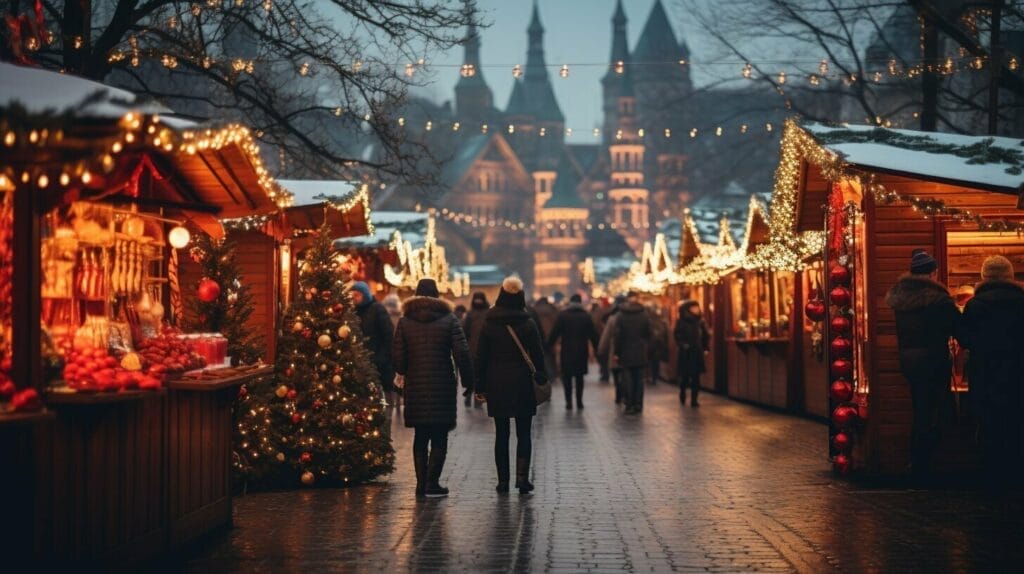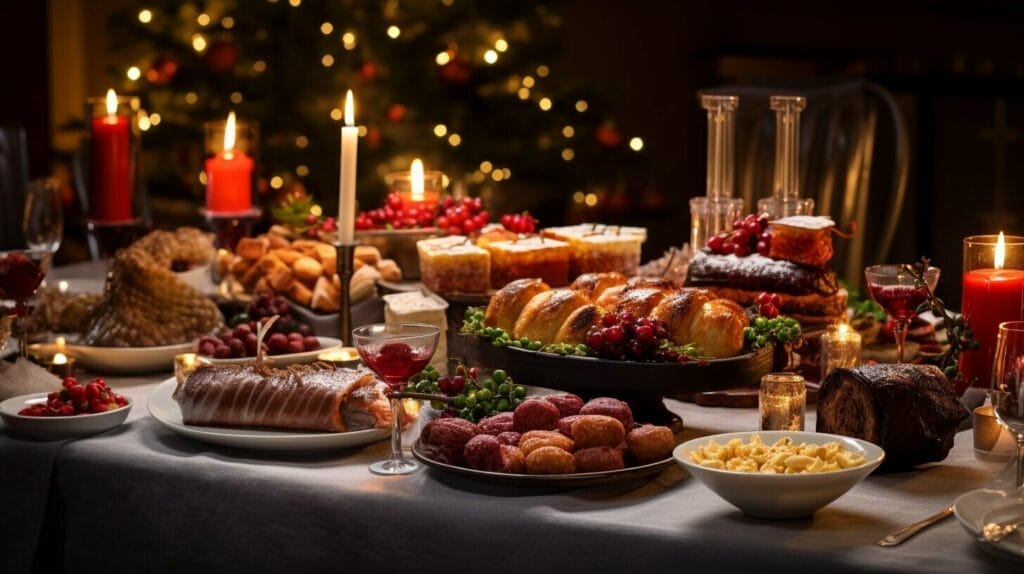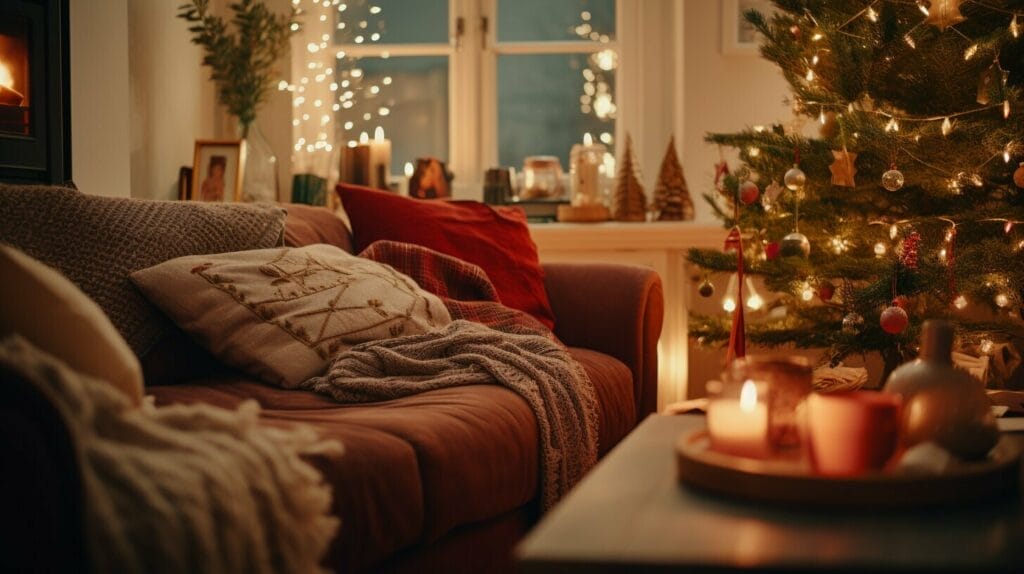Danish Christmas Traditions
Danish Christmas Traditions are filled with joy, warmth, and unique customs that bring families together during the festive season. Christmas, known as Jul in Denmark, is a time of celebration and cherished rituals. From the enchanting Danish Christmas markets to the delicious traditional food and cozy atmosphere, Christmas in Denmark is truly special.
- Danish Christmas is known as Jul and is a time of celebration and family togetherness.
- Danish Christmas markets offer handmade crafts, treats, and a festive atmosphere.
- A traditional Danish Christmas lunch called Julefrokost is held about six weeks before the holiday.
- Danish Christmas decorations feature candles and pine-inspired decor, creating a cozy ambiance.
- Christmas Eve is the main celebration in Denmark, with an elaborate dinner, dancing around the Christmas tree, and opening presents.
These Danish holiday customs and traditions bring joy and festive cheer during the holiday season. Whether it’s enjoying a delicious Christmas feast, lighting advent candles, or making homemade decorations, Danish Christmas traditions are a beautiful way to celebrate with loved ones.
Danish Christmas Markets
Danish Christmas markets are a highlight of the holiday season, offering a wide range of handmade crafts, delicious treats, and a joyful atmosphere. These markets, known as julemarkeder, are held throughout Denmark and attract locals and tourists alike. Whether you’re looking for unique gifts or simply want to soak up the festive ambiance, a visit to a Danish Christmas market is a must.

At the markets, you’ll find an abundance of traditional Danish crafts, such as wooden ornaments, knitted accessories, and intricate glassware. These handmade creations make perfect gifts for loved ones or treasured keepsakes for yourself.
The markets also showcase local Danish cuisine, from traditional Christmas treats like æbleskiver (pancake puffs) and gløgg (mulled wine) to savory delights like flæskesteg (roast pork) and frikadeller (meatballs).
The atmosphere at Danish Christmas markets is magical, with twinkling lights, festive music, and the scent of freshly baked goods filling the air. You can stroll through rows of stalls, sipping on warm drinks and sampling Danish delicacies as you browse for one-of-a-kind treasures. Many markets also feature live performances, carol singers, and even visits from Santa Claus himself, adding to the festive spirit.
In addition to the markets, Denmark hosts a variety of Christmas events during the holiday season. From ice skating rinks to holiday-themed exhibitions, there are plenty of activities to keep you entertained.
One popular event is the Tivoli Gardens Christmas market in Copenhagen, which is known for its stunning decorations, Christmas rides, and festive atmosphere. Another highlight is the Aarhus Christmas Market, held in the country’s second-largest city, featuring a magical winter wonderland complete with ice sculptures and a Santa’s Grotto.
Whether you’re a local or a visitor, Danish Christmas markets and events offer a delightful way to immerse yourself in the holiday spirit. From the enchanting decorations to the mouthwatering food, these festive gatherings capture the essence of Danish Christmas traditions. So bundle up, grab a cup of hot cocoa, and explore the wonders of Danish Christmas markets – you’re sure to create memories that will last a lifetime.
Danish Christmas Food
Danish Christmas food is a feast for the senses, with mouthwatering dishes that are sure to delight your taste buds and fill your belly. It’s a time when traditional recipes are passed down through generations, creating a sense of nostalgia and bringing loved ones together around the table.

One of the most popular dishes during the Danish Christmas season is roast pork, known as flæskesteg. This delicious dish features crispy crackling on the outside and tender, juicy meat on the inside. It’s often served with boiled potatoes, which are perfectly cooked until they are soft and creamy.
Another festive favorite is roast duck, or andesteg. The duck is seasoned and roasted to perfection, resulting in succulent meat and crispy skin. It pairs perfectly with caramelized potatoes, a sweet and savory side dish that adds a unique touch to the meal. And of course, no Danish Christmas feast would be complete without pickled red cabbage, which adds a tangy and colorful element to the plate.
For dessert, Ris a l’Amande is a must-have. This creamy rice pudding is mixed with whipped cream, almonds, and a hint of vanilla. A whole almond is hidden within the pudding, and the lucky person who finds it in their serving is crowned the “Almond King” or “Almond Queen” and receives a prize.
| Dish | Description |
|---|---|
| Roast Pork (Flæskesteg) | Tender, juicy pork with crispy crackling |
| Roast Duck (Andesteg) | Succulent duck with crispy skin |
| Boiled Potatoes | Soft and creamy potatoes |
| Caramelized Potatoes | Sweet and savory potatoes |
| Pickled Red Cabbage | Tangy and colorful cabbage |
| Ris a l’Amande | Creamy rice pudding with almonds |
Traditional Danish Christmas Food
- Roast Pork (Flæskesteg)
- Roast Duck (Andesteg)
- Boiled Potatoes
- Caramelized Potatoes
- Pickled Red Cabbage
- Ris a l’Amande
“Danish Christmas food is a feast for the senses, with mouthwatering dishes such as roast pork, roast duck, boiled potatoes, caramelized potatoes, pickled red cabbage, and the beloved dessert, Ris a l’Amande.”
Danish Christmas food is more than just a meal. It’s a celebration of tradition, love, and togetherness. So gather your loved ones, light some candles, and indulge in the flavors of a Danish Christmas.
Danish Christmas Decorations
Danish Christmas decorations are characterized by a cozy and understated elegance, featuring lots of candles and natural elements like pine branches and homemade decorations. The Danish believe in creating a warm and welcoming atmosphere during the holiday season, and their decorations reflect this sentiment.
Candles play a significant role in Danish Christmas decorations. They are often placed in windowsills to light up the dark winter nights and create a cozy ambiance inside and outside the home. The warm glow of candlelight adds a touch of magic to the holiday season.
In addition to candles, Danish Christmas decorations incorporate natural elements. Pine branches, holly, and mistletoe are commonly used to adorn homes, adding a touch of greenery to the festive atmosphere. These natural elements bring a sense of freshness and vitality to the decorations.
Homemade decorations are also highly valued in Danish Christmas traditions. Families often gather together to craft ornaments, garlands, and other festive creations. These DIY decorations add a personal touch and make the holiday season even more special. From paper snowflakes to woven heart baskets, each homemade decoration is a labor of love.
“Danish Christmas decorations are characterized by a cozy and understated elegance, featuring lots of candles and natural elements like pine branches and homemade decorations.”
Homemade Decorations
The tradition of making homemade decorations has been passed down through generations in Denmark. Families take pride in creating unique and meaningful ornaments that can be cherished year after year. From intricate paper cutouts to woven straw ornaments, the craftsmanship and attention to detail are evident in these homemade decorations.

Not only are homemade decorations a way to personalize the holiday season, but they are also a sustainable choice. By reusing materials and creating their own unique designs, the Danes embrace the idea of reducing waste and being mindful of the environment.
When it comes to Danish Christmas decorations, simplicity and elegance are key. The focus is on creating a warm and inviting atmosphere that evokes feelings of hygge, the Danish concept of coziness and contentment. By incorporating candles, natural elements, and homemade decorations, the Danes create a festive and memorable holiday experience for all.
Danish Christmas is all about hygge, a unique concept that encompasses coziness, warmth, and a sense of togetherness during the holiday season. Pronounced “hoo-gah,” hygge is a fundamental aspect of Danish culture and is deeply ingrained in their Christmas traditions. It is all about creating a warm and inviting atmosphere where people can relax, enjoy each other’s company, and find comfort in simple pleasures.
During Christmas, Danes go to great lengths to create a hyggelig ambiance in their homes. Candles play a significant role in setting the mood, with soft, warm lighting creating a cozy atmosphere. Danish homes are often adorned with handmade decorations, such as woven heart ornaments and paper snowflakes, adding a personal touch to the festive surroundings.
To further enhance the hygge experience, families gather around the Christmas tree, exchanging stories, laughter, and enjoying traditional Danish Christmas food. The scent of mulled wine and freshly baked treats fills the air, heightening the feeling of warmth and comfort. Danish Christmas is a time to slow down, savor the moment, and appreciate the simple joys of being together.

Embracing the spirit of hygge extends beyond the home during Danish Christmas celebrations. Communities come together to enjoy festive events, such as Christmas markets, where the cozy atmosphere is palpable. Visitors can browse through stalls adorned with handmade crafts, sip on warm beverages, and indulge in delicious treats, all while soaking in the joyful ambiance. It’s a time to connect with others, make lasting memories, and revel in the holiday spirit.
| Hygge Elements | Description |
|---|---|
| Warm lighting | Candles and soft lighting create a cozy atmosphere. |
| Handmade decorations | Personalized ornaments add a special touch to the festive surroundings. |
| Festive gatherings | Families and communities come together to enjoy each other’s company and celebrate the holiday season. |
“Danish Christmas is a time to slow down, savor the moment, and appreciate the simple joys of being together.”
The concept of hygge encapsulates the true essence of Danish Christmas traditions. It’s about creating a warm and inviting atmosphere, cherishing time spent with loved ones, and finding joy in the little things. Danish Christmas is a celebration of togetherness and the perfect time to embrace the hygge spirit.
Danish Christmas Rituals
Danish Christmas rituals include lighting advent candles, hanging stockings for small gifts from the “nisse,” and spending time together making homemade decorations. These cherished traditions are an integral part of the festive season and create a sense of warmth and togetherness. Let’s explore these rituals in more detail.
Lighting Advent Candles
Advent is an important period leading up to Christmas, and many Danish families celebrate it by lighting advent candles. These candles are typically arranged in an advent wreath or a candleholder, and a new candle is lit each Sunday before Christmas. It is a time for reflection and anticipation as the countdown to Christmas begins.
Hanging Stockings
In Denmark, children eagerly hang stockings in the hope of receiving small gifts from the mischievous “nisse.” These Christmas elves are believed to bring good fortune and protect the household. The stockings are usually hung by the fireplace or the Christmas tree, ready to be magically filled overnight.
Making Homemade Decorations
One of the most cherished Danish Christmas rituals is the tradition of making homemade decorations. Families come together to create beautiful ornaments using natural materials like pinecones, dried orange slices, and ribbons. These handmade decorations add a personal touch to the festive atmosphere and create lasting memories.
Embracing these Danish Christmas rituals is a way to connect with the rich cultural heritage of Denmark. Whether it’s the warm glow of advent candles, the excitement of finding small surprises in stockings, or the joy of crafting homemade decorations, these traditions bring joy and festive cheer during the holiday season.
Danish Christmas Celebrations
Danish Christmas celebrations revolve around Christmas Eve, with an elaborate dinner, dancing around the Christmas tree, and the opening of presents, followed by visiting relatives and enjoying a traditional Christmas lunch on Christmas Day.

On Christmas Eve, families gather together for a festive dinner that typically includes a variety of traditional Danish dishes. Roast pork and roast duck are popular main courses, accompanied by boiled potatoes, caramelized potatoes, and pickled red cabbage. For dessert, the beloved Ris a l’Amande, a creamy rice pudding with chopped almonds, is served. In some families, a whole almond is hidden in the pudding, and whoever finds it receives a small gift or is crowned the “Almond Queen” or “Almond King.”
After dinner, the family gathers around the Christmas tree, which is beautifully decorated with candles, ornaments, and homemade crafts. The Christmas tree is traditionally lit with real candles, creating a warm and cozy atmosphere. As the candles flicker, everyone holds hands and dances around the tree, singing traditional Christmas carols.
The highlight of the evening is the opening of presents. In Denmark, it is customary for each family member to take turns opening one gift at a time, allowing everyone to appreciate the joy and excitement of each present. Once all the presents have been opened, the evening continues with the enjoyment of festive treats, playing games, and spending quality time together.
On Christmas Day, it is common for Danish families to visit relatives and enjoy a traditional Christmas lunch. This lunch often includes an assortment of cold cuts, cheeses, pickled herring, and other delicacies. It is a time for sharing stories, laughter, and creating cherished memories with loved ones.
These Danish Christmas traditions bring joy and festive cheer during the holiday season. They embody the spirit of togetherness and create a sense of warmth and coziness, known as “hygge,” that is characteristic of Danish culture. Whether it’s the delicious food, the homemade decorations, or the joy of celebrating with loved ones, Danish Christmas celebrations are truly special.
FAQ
Q: What are some Danish Christmas traditions?
A: Danish Christmas traditions include lighting advent candles, dancing around the Christmas tree, and visiting relatives on Christmas Day.
Q: What is Julefrokost?
A: Julefrokost is a traditional Danish Christmas lunch held about six weeks before the holiday. It involves lots of food and drinks.
Q: What can I find at Danish Christmas markets?
A: Danish Christmas markets offer handmade crafts and treats, providing a festive and enjoyable shopping experience.
Q: What are some traditional Danish Christmas foods?
A: Traditional Danish Christmas foods include roast pork, roast duck, boiled potatoes, caramelized potatoes, pickled red cabbage, and the popular dessert Ris a l’Amande.
Q: What are Danish Christmas decorations like?
A: Danish Christmas decorations are relatively subdued, featuring lots of candles and pine-inspired decor. Homemade decorations are also common.
Q: What is the concept of hygge during Danish Christmas?
A: The concept of hygge embraces coziness, warmth, and togetherness during Danish Christmas celebrations.
Q: What are some Danish Christmas rituals?
A: Danish Christmas rituals include lighting advent candles, hanging stockings for small gifts, and making homemade decorations to create a festive atmosphere.
Q: What are the main Danish Christmas celebrations?
A: Christmas Eve is the main celebration in Denmark, with an elaborate dinner, dancing around the Christmas tree, and opening presents. Christmas Day is spent visiting relatives and enjoying a traditional Christmas lunch.




